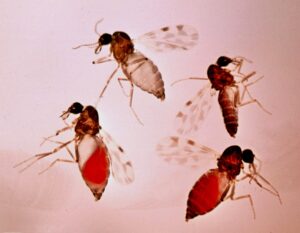Bluetongue (BT) is a viral disease spread by midges. It affects sheep, causing acute disease with high morbidity and mortality. The Bluetongue virus (BTV) also infects goats, cattle, and other domestic animals, as well as wild ruminants.
It causes a severe haemorrhagic disease that gets its name from one of the symptoms, cyanosis of the tongue. Caused by a reduction in oxygen carriage by haemoglobin, cyanosis gives the tongue a typical blue appearance. Other symptoms include fever, lesions, excessive salivation and nasal discharge.
Humans are not affected by BT, and it is safe to eat meat or milk from infected animals.
The occurrence of more than twenty-nine BTV serotypes is now recognised to be the result of the high variability of a single outer capsid protein, VP2.
The vector

Originally, the main vector of BT was Culicoides imicola, a midge that also spreads African Horse Disease. Historically found in subtropical Africa and Asia, C. imicola has slowly made its way north into southern Europe. This spread has been attributed to climate change, as warmer temperatures become the norm around the Mediterranean. By 1998 this midge had introduced BT into the Mediterranean Basin and within an 8-year period at least 6 BTV strains, belonging to 5 serotypes, were reported.
In Mediterranean countries the disease is now seasonal as C. imicola cannot survive low temperatures and frost. Thus, the report of cases of BT in northern Europe came as a surprise.
It appears that climate change did not account for the rapid spread of BT northwards beyond the Mediterranean.
New vectors
Although C. imicola cannot survive in northern Europe many other midge species can, including C. obsoletus and C. pulicaris. Both can transmit BTV and are acting as novel vectors that have enabled the virus to spread northwards much faster than climate change would allow.
The first BTV epidemic in northern Europe

The first case of BT in northern Europe was detected in 2006, in the Netherlands. It was caused by the serotype BTV-8. It rapidly spread to Belgium, Germany, and Luxembourg and became a serious threat in Scandinavia and Switzerland. The economic losses were substantial, but the epidemic was ended with a new, very effective vaccine.
A new epidemic
The current epidemic is caused by a relatively new variant, a highly virulent serotype, BTV-3. Initially identified in the Netherlands in September 2023, it spread rapidly across the country causing 75% mortality in sheep; far more than the BTV-8 serotype. The disease abated in the winter when the midges died out after laying eggs in the soil, but it reappeared in May this year.
Vaccines containing killed copies of BTV-3, and an adjuvant, were quickly developed by three companies and given emergency approval for use this year. Initially, 8 farms in the Netherlands reported a reduction in sheep mortality following vaccination, but farmers were dissatisfied with the protection given, as many sheep were still dying, and farmers have lost confidence in the vaccines.
The situation in Britain
The likelihood of infected midges being blown across the Channel into Britain is weather dependent. In 2023 the infection did not reach the UK until November, but this year the National Union of Farmers report that infections are already present in the South and East of England, and rapidly spreading
Notice of an extended restriction zone was given on October 4th and the zone extended on 10th October. The first case in Wales has now been reported.
Free testing is available for animals moving from the highest risk counties in Britain and use of the three unauthorised serotype BTV-3 vaccines has been permitted, but it is acknowledged that, although they reduce viraemia, they do not prevent infection or its spread to other herd members.
The future
Hopefully BTV-3 may become less virulent, as happened with BTV-4 and BTV-8 in France. Until then, surveillance and vaccination are key to confinement of the disease and, hopefully, improved BTV-3 vaccines will be developed.
This story illustrates a worrying scenario whereby climate change may slowly facilitate the extension of the range of disease vectors to bring them into the range of potential novel vectors that then accelerates the spread of the disease into areas previously unsuitable for transmission by the initial vector.
Comments